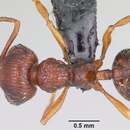pt-BR
nomes no trilho de navegação


Perissomyrmex M. R. Smith 1947: 281. Type-species: Perissomyrmex snyderi , by original designation.
DIAGNOSIS
Worker and Female
Monomorphic or polymorphic terrestrial myrmicine ants with the following combination of characters:
1. Head almost as broad as long in minor worker, or slightly broader in major worker, divergent anteriorly.
2. Eyes protruding, situated at about the midlength of the side of head, or slightly posteriorly.
3. Clypeus with a few paired teeth on the anterior margin; lateral portions reduced to a thin raised strip in front of the antennal insertions.
4. Frontal lobe absent; frontal carina poorly developed.
5. Antennal toruli exposed.
6. Antennae 9 - segmented, scape extending over posterior border of head, apical 3 segments forming a club.
7. Mandibles with long basal margin and short masticatory margin; basal margin with a distinct tooth; masticatory margin with one basal and two apical teeth separated by a diastema.
8. Labrum with transverse ridge at the preapical portion.
9. Palp formula 4,2.
10. Pronotum unarmed, promesonotal suture weakly impressed.
11. Lower part of mesopleuron not expanding to cover on procoxa.
12. Metanotal groove deeply impressed.
13. Propodeal spiracle rounded situated in the middle of lateral surface of propodeum.
14. Propodeal spine long and acute.
15. Propodeal lobe low and obtuse angled.
16. Petiole pedunculate with lateral projection, petiolar node rounded.
17. Postpetiole with rounded node.
Male Unknown.
Of the four species of the genus, P. snyderi is easily diagnosed by the presence of a subpetiolar process in the workers, the dentition of the anterior margin of the clypeus and the coarse and irregular sculpturation on the head. This does not mean that the three Asian species comprise a monophyletic group. Because the loss of the subpetiolar process is frequently observed in Myrmecina and Pristomyrmex , we do not confirm the polarity of the character state of the dentition and the sculpture. There is no strong evidence, however, that Central American snyderi has a close relationship with any of the Asian species. The detailed phylogeny of the four species is not clear.
The polymorphism of the genus was reported by Longino & Hartley (1994) in P. snyderi from Mexico. While no Asian species are known to be polymorphic, it is possible. Because the available materials were mostly from litter extractions, whole colony composition has not been clear.
It should be noted that the individuals of the Perissomyrmex are highly variable in the morphology. In particular, projected structures, such as teeth on the mandibles, propodeal spines, lateral projections on the petiolar peduncle, are varying due to wearing down or polymorphism.